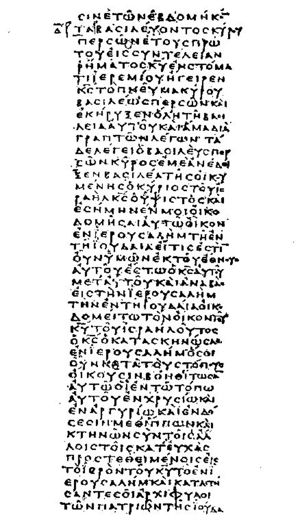Codex Vaticanus
The Codex Vaticanus (The Vatican, Bibl. Vat., Vat. gr. 1209; Gregory-Aland no. B or 03) is one of the oldest extant manuscripts of the Bible. It is slightly older than Codex Sinaiticus, both of which were probably transcribed in the 4th century. It is written in Greek, on vellum, with uncial letters.
Contents
[hide]Contents
Vaticanus originally contained a complete copy of the Septuagint ("LXX") except for 1-4 Maccabees and the Prayer of Manasseh. Genesis 1:1-46:28a (31 leaves) and Psalm 105:27-137:6b (10 leaves) are lost and have been filled by a recent hand. 2 Kings 2:5-7, 10-13 are also lost due to a tear in one of the pages. The order of the Old Testament books is as follows: Genesis to 2 Chronicles as normal, 1 and 2 Esdras, the Psalms, Proverbs, Ecclesiastes, Song of Songs, Job, Wisdom, Ecclesiasticus, Esther, Judith, Tobit, the minor prophets from Hosea to Malachi, Isaiah, Jeremiah, Baruch, Lamentations and the Epistle of Jeremiah, Ezekiel and Daniel.
The extant New Testament of Vaticanus contains the Gospels, Acts, the General Epistles, the Pauline Epistles and Hebrews (up to Heb. 9:14, καθαριει); thus it lacks 1 and 2 Timothy, Titus, Philemon and Revelation. These missing pages were replaced by a 15th century minuscule supplement (no. 1957).
The Greek is written continuously with small neat writing, later retraced by an 11th century scribe. Punctuation is rare (accents and breathings have been added by a later hand) except for some blank spaces, diaeresis on initial iotas and upsilons, abbreviations of the nomina sacra and markings of Old Testament citations.
The manuscript contains mysterious double dots (so called "umlauts") in the margin of the New Testament, which seem to mark places of textual uncertainty. There are 795 of these in the text and around another 40 that are uncertain. The date of these markings are disputed among scholars and are discussed in a link below.
On page 1512, next to Hebrews 1:3, the text contains an interesting marginal note, "Fool and knave, can't you leave the old reading alone and not alter it!" which suggests that inaccurate copying, either intentional or unintentional, was a known problem in scriptoria.[1]
Provenance
The manuscript has been housed in the Vatican Library (founded by Pope Nicholas V in 1448) for as long as it has been known, appearing in its earliest catalog of 1475 and in the 1481 catalogue. Its place of origin and the history of the manuscript is uncertain, with Rome, southern Italy, and Caesarea all having been suggested. There has been speculation that it had previously been in the possession of Cardinal Bessarion because the minuscule supplement has a text similar to one of Bessarion's manuscripts. According to Paul Canart's introduction to the recent facsimile edition, p.5, the decorative initials added to the manuscript in the middle ages are reminiscent of Constantinopolitan decoration of the 10th century, but poorly executed, giving the impression that they were added in the 11th or 12th century. T C Skeat, a paleographer at the British Museum, first argued that Codex Vaticanus was among the 50 Bibles that the Emperor Constantine I ordered Eusebius of Caesarea to produce. The similarity of the text with the papyri and Coptic version (including some letter formation), parallels with Athanasius' canon of 367 suggest an Egyptian or Alexandrian origin.
Importance
Codex Vaticanus is one of the most important manuscripts for textual criticism and is a leading member of the Alexandrian text-type. It was heavily used by Westcott and Hort in their edition, The New Testament in the Original Greek (1881).
Source
References
- Jump up ↑ Codex Vaticanus Graece 1209, B/03, A critical note. Dr. Wieland Willker, University of Bremen. Retrieved on 2008-02-12.
External links
- Codex Vaticanus NT Facsimile edition in PDF format. 16MB download
- Codex Vaticanus B/03 Detailed description of Codex Vaticanus with many images and discussion of the "umlauts."
Further reading
- H.J.M. Milne and T.C. Skeat "Scribes and Correctors", London 1938
- Janko Sagi "Problema historiae codicis B", Divius Thomas 1972, 3-29
- T.C. Skeat "The Codex Vaticanus in the 15th Century.", JTS 35 (1984) 454-65
- T.C. Skeat "The Codex Sinaiticus, the Codex Vaticanus and Constantine.", JTS 50 (1999) 583-625
- Philip B. Payne "Fuldensis, Sigla for Variants in Vaticanus and 1 Cor 14.34-5.", NTS 41 (1995) 251-262 [Payne discovered the first umlaut while studying this section.]
- Curt Niccum "The voice of the MSS on the Silence of the Women: ...", NTS 43 (1997) 242-255
- Philip B. Payne and Paul Canart "The Originality of Text-Critical Symbols in Codex Vaticanus.", Novum Testamentum 42 (2000) 105-113
- J. Edward Miller "Some Observations on the Text-Critical Function of the Umlauts in Vaticanus, with Special Attention to 1 Corinthians 14.34-35.", JSNT 26 (2003) 217-236 [Miller disagrees with Payne on several points. He notes and uses this website.]
- Philip B. Payne and Paul Canart "The Text-Critical Function of the Umlauts in Vaticanus, with Special Attention to 1 Corinthians 14.34-35: A Response to J. Edward Miller.", JSNT 27 (2004) 105-112 [Payne still thinks, contra Miller, that the combination of a bar plus umlaut has a special meaning.]

